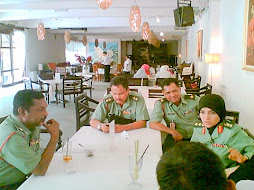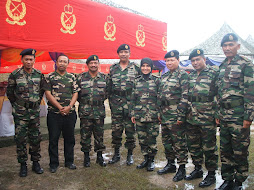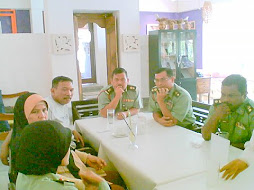Adapun sebermulanye crite puluhan punama yang lalu. Maka tiadalah rasa gumbiranya melainkan gumbira yang amat sangat adanye bila perkhabaran diterima untuk bertugas di negara sebelah sana.
Di negara yang orangnye putih-putih belaka, hidungnye tinggi-tinggi belaka, kakinye panjang-panjang belaka, rambutnye macam-macam warna. Pendek kata ganteng-ganteng dan come-come belaka adanye.
Tapi cara bernegaranye tiadalah sama seperti negara kite, dan pastinye makannye juga jauh berbeza, cuacanye tak tentu hala, apatah lagi budayanye bagai langit dengan bumi adanye. Tapi berkelana ditempat asing yang orangnye ganteng-ganteng dan come-come belaka mungkin ada syoknye. Sekurang-kurangnye dapat gak menjamu mata, menambah ilmu didada sambil meluaskan pemandangan adanye. Ialah orang yang putih-putih ni senang je hidupnye. Bila panas ditutup semua, bila sejuk dibuka semua. Kan ke pengalaman baru tu namanye.
Poland itulah namanye. Macam biasa dengar nama tu tapi tak tau apa punya negara tuu. Ialah kat kampong dolu-dolu, Pontian dulupun dipanggil Poland. Tu yang buat kegumbiraan hingga tak terkata. Tambah lak dikhabarkan ke sana untuk membeli kereta yang maha keras katanye, ada bedil macam-macam rupa, tayarnye berantai tak beroda, bunyinye lak gegak gumpite. Tentulah hebat kereta besi tu dan tambah menyeronokan tugas yang akan diterime.
Maka pada tanggal 3 bulan terakhir tahun 2003, terbanglah ia ke Poland bersama seisi keluarga. Yang jauh datang berbondong, yang dekat datang melolong, lembu kerbau habis dipotong. Maka tiadalah tumpah air mata melainkan bertong-tong yang berhamburan. Tiada lain lah yang dikhuatiri melainkan ditakuti orng yang akan ke negari orang yang putih-putih ni jadi hantu polang jua adanye bila balik ke kampong.
Maka, itulah mukadimah dari aku Skot. Jangan boring lak baca coretan kat atas tuh. Sebelum aku kongsi pengalaman kat Poland ni elok kite kenal dulu Poland tu apa. Ialah kalau nak makan rumput mesti lah kena tau rumput yang macamana. Nak makan burung pun kena tau burung yang macammana, jangan main hemtan yang menyicau tu burung. Nanti dikata orang orang gila lak.
Ikutilahhhhhhh
Proud Poland has been crushed flat so many times it's become indestructible.
A brief history of Poland in the last 200 years

 The map of Central Europe in 1772. The Kingdom of Poland is marked in white; Russia - in green, Austria - in yellow and Prussia - in blue. Present-day political boundaries are shown as red lines. Present names of cities are also given.
The map of Central Europe in 1772. The Kingdom of Poland is marked in white; Russia - in green, Austria - in yellow and Prussia - in blue. Present-day political boundaries are shown as red lines. Present names of cities are also given.
During the second half of the 18th century the Kingdom of Poland was a country which differed from present-day Poland in many important ways. Its territory included all of what we now call Lithuania, Belarus and half of contemporary Ukraine. On the other hand, nearly half of the contemporary area of Poland then belonged to Prussia (or, less precisely - to Germany). From time immemorial all those territories had been inhabited by diverse peoples of several religions.
The western and central regions of the Kingdom were inhabited mostly by Catholics of Polish ethnic background. Catholic Poles and Lithuanians lived in its north-eastern section, which is now the Republic of Lithuania. The eastern regions were inhabited by Byzantine Catholics of Ruthenian (which is now Belarussian and Ukrainian) background and a small but important Catholic Polish minority. All parts of the Polish Kingdom were also inhabited by Jews (about 10% of the whole population) who lived mostly in shtetls, i.e. tiny cities. Also other ethnic groups, e.g. Germans, Armenians, Tartars, Scots, Dutchmen, etc. were represented. The Prussian provinces of Pomerania, Silesia and East Prussia which now belong to Poland also had a considerable Polish minority, although the majority was of German ethnic background. Pomerania and East Prussia were traditionally Lutheran, whereas most of the Silesian people belonged to the Roman Catholic Church.
 At the top: the map of Central Europe in 1795 (right after the partitions). At the bottom: the situation after the Vienna Congress in 1815. The autonomous Kingdom of Poland shown in light green.
At the top: the map of Central Europe in 1795 (right after the partitions). At the bottom: the situation after the Vienna Congress in 1815. The autonomous Kingdom of Poland shown in light green.
Between 1772 and 1795 the entire territory of the Kingdom of Poland was divided between Prussia, Austria and Russia. During those so-called Partitions of Poland, Prussia acquired the western regions of Poland, esp. those, which were later renamed to West Prussia (formerly Royal Prussia) and Province of Posen (the area around Poznan, the Polish name being Wielkopolska, i.e. Greater Poland). The southern Polish territories around Kraków and Lwów were incorporated into the Austrian Empire and renamed "Galicia". The central and eastern provinces of Poland were taken over by the Russian Empire. Only during a short period when Napoleon Bonaparte conquered Central Europe, he restored Poland as a Duchy of Warsaw, dependent on himself, consisting of the territories Prussia and Austria had annexed in 1793-95.
After Napoleon's fall, the situation was finally resolved in 1815. The victorious Russia took control over most of the Duchy of Warsaw. The Tzars gave it relatively much autonomy and created the new Kingdom of Poland there (but dependent on Russia) whereas the former eastern parts of Poland were directly incorporated into the Empire (and the populace of the Byzantine Catholics living there was forced to "convert" to Eastern Orthodox). The boundaries fixed in 1815 were stable during the next century but many other things changed. The 19th century was the time of industrial development and massive migrations. The Polish provinces under Prussian government were slowly germanized as more and more Germans settled there. Several attempts to regain independence were made by Poles, but all the uprisings against Russia, Prussia and Austria were bloodily suppressed. That was one of the reasons why in the last three decades of the 19th century more than a million people emmigrated from Poland, mostly to North America.
The First World War was a catastophe for all the Empires that had once divided Poland. An independent Republic of Poland was restored. Most of the 19th century Kingdom of Poland, the whole Galicia and most of the former Prussian provinces of West Prussia and Posen together with some areas of present-day Belarus, Lithuania and Ukraine constituted Poland between the Wars. Most German inhabitants of the former Prussian provinces emigrated to Germany.
 At the top: the map of Central Europe in 1920. At the bottom: in 2000.
At the top: the map of Central Europe in 1920. At the bottom: in 2000.
As the Second World War began, Poland was attacked by Nazi Germany and the Soviet Union. Both totalitarian countries divided Poland and began to persecute her people. The Nazis murdered about 90% of the Polish Jews and more than a million of Catholic Poles. The Soviets also murdered a comparable number of Poles, many others experienced to concentration camps in Siberia. After this horrible period was over and World War II had ended, new boundaries were designed for Central Europe by Stalin, Churchill and Roosevelt at Yalta. Poland lost a third of its pre-WWII area which was taken over by the Soviets. As a "compensation", the allied powers handed over to Poland a large part of Germany east of the Oder and Neisse rivers. Nearly the entire population of those provinces either escaped the Red Army in 1945 or was later expelled to Germany and the territory was settled by Polish refugees from the East, who wanted to avoid Soviet rule. Also hundreds of thousands of Ukrainians were forced to leave Poland to settle in the Soviet Union. Most of the Jews who survived the Holocaust emigrated to Israel or to the USA.
Because of those migrations, contemporary Poland has practically no population of ethnic minorities - about 5% in total. Except for a few hundred thousand of Germans in Silesia and comparable numbers of Belarussians (in the Easternmost regions) and Ukrainians, all other minorities do not exceed 100,000 people.This is a situation completely different from that throughout the whole of Polish history.
BRIEF HISTORY OF KRAKOW
Without Krakow there would be no Poland. For in this beautiful city lies much of Poland's rich historical, cultural and intellectual panoply.
Krakow has miraculously escaped destruction towards the end of the last war, for the retreating Nazis had every intention of turning Krakow, like Warsaw into fields of rubble. But in January 1945, the Red Army under Marshal Koner outflanked the Germans, obliging them to flee before they could blow the city up.
Krakow, the former capital of Poland has a population of over 700,00, is the third largest centre after Warsaw and Lodz.
Founded over a thousand years ago, it is not definitely known who founded the city but the folks have their little folklore on this matter.
In the 11th century, Krakow was the main seat of the first Polish kings of the Piast dynasty.
In 1241, after a Tartar raid, the settlements situated around the Wawel Hill were greatly destroyed.
In 1320, the first crowning ceremony of Ladislaus the Short in the Wawel Cathedral strengthened the rank of the capital city of Krakow.
In 1333, under the last king from the Piast dynasty, Casimir the Great (1333-1370), the city became a rightful member of the Western culture.
1364 - The establishment of a university, renovated under King Ladislaus Jagiello (1386- 1434), the first King from the Jagiellon family. It was to become one of the most important European university schools. Many eminent scientists received their education here, including the great Nicolaus Copernicus.
At the turn of the 15th and 16th centuries, the Jagellions forged the first dynastic power in Central Europe, and Krakow became the leading city in this part of the European continent. The Renaissance culture inspired by Italian, German and Dutch centers was in full bloom. After the death of King Sigismund Augustus, the last ruler of the Jagellion family, the age of bloom and development of Krakow came to an end.
1569 - Poland united with Lithuania. Krakow became situated on the periphery of the large country and gradually lost its political importance in favour of the centrally situated Warsaw.
1609 - King Sigismund III (1587-1632), the first Polish king of the Vasa dynasty, decided to transfer his seat to Warsaw.
1655 - Krakow was captured for the first time and plundered by the Swedes.
1795 - After the fall of Poland, Krakow became part of the Austrian empire.
1918 - Poland regained it's independence and the city slowly began to be restored to life. This was later interrupted by the Second World War when the captive city played an inglorious role of the capital of German-occupied Poland. Krakow beccame a place of martyrology of the Jewish nation; Jews were first confined to the Krakow ghetto, later taken to the Plaszow camp, wherefrom they were taken away to Auschwitz.
After the war, significant sociological changes took place in Krakow, chiefly related to the uncontrolled development of industry. In 1978, Krakow was recognized by the UNESCO as a monument of world culture and is now a place where international cultural events are organized periodically.
Tentu tertanya-tanya kenapa lak aku tulis crote pasal salah satu bandar kat Poland tu, KRAKOW. Sebenrnye kami tinggal di Krakow yang terletak 150km ke tenggara Gliwice dimana kami bekerja. Dalam musim panas perjalanan yang 70% highway mengambil masa sehingga 2 jam. Kalau musim salji, kekadang mengambil masa sehingga 4 ke 5 jam. Kami terpaksa tinggal jauh dari tempat kerja kerana hanya di Krakow yang ada sekolah international iaitu BRITISH INTERNATIONAL OF CRACOW (BISC).
 Rumah Kami (Krakow)
Rumah Kami (Krakow)Pejabat Kami (Gliwice)
Sampai sini dulu mukadimah skot. Episod akan datang SEHARIAN DI POLAND. Sampai ketemu lagi.









.jpg)




.jpg)










No comments:
Post a Comment